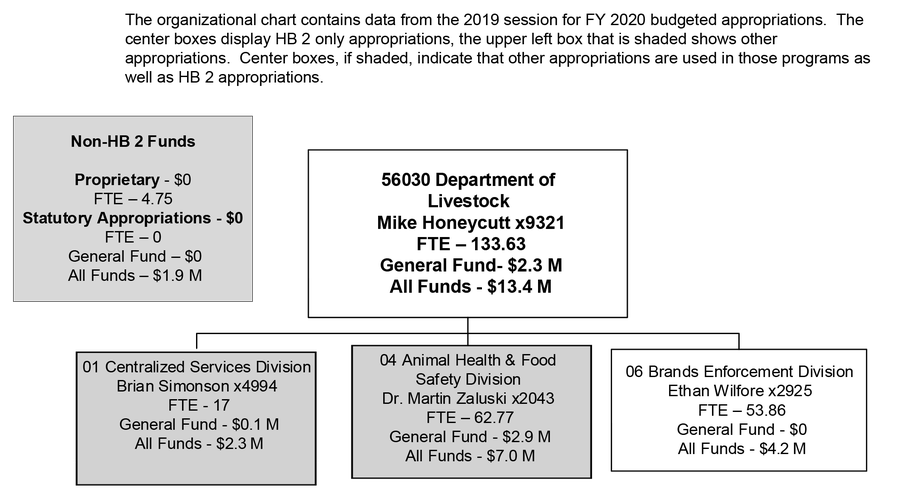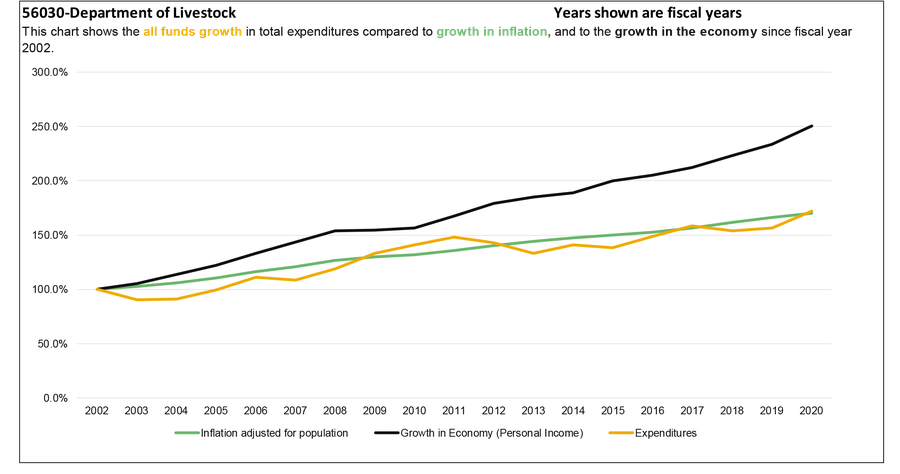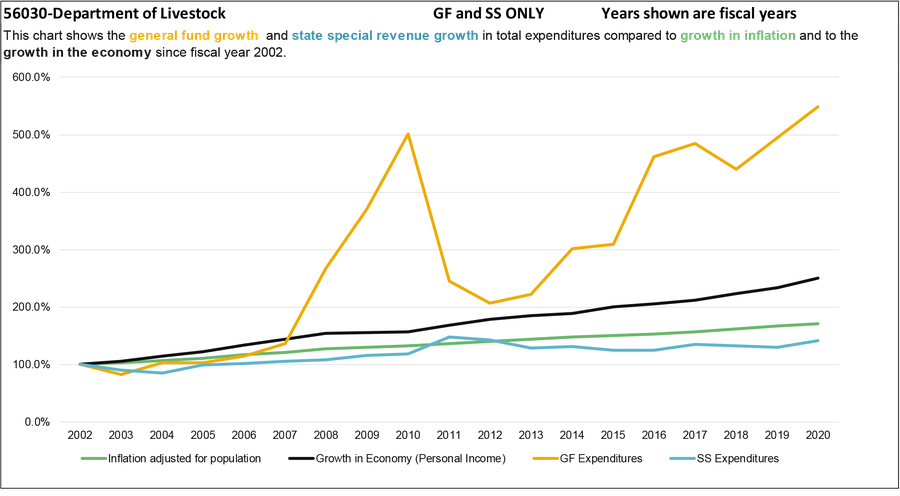Montana State Legislature
Department of Livestock
The Department of Livestock (Livestock) regulates domesticated animals. The mission includes protecting the livestock industry; controlling and eradicating animal diseases; and inspecting meat, milk, and eggs. The Board of Livestock serves as the statutory department head and consists of seven appointed members serving six year terms.
Six divisions form the Department of Livestock and perform the following functions:
- The Centralized Services Division provides managerial and administrative support services to the entire department
- The Diagnostic Laboratory Division supplies veterinary laboratory testing services to producers, veterinarians, animal owners, and other government entities
- The Animal Health Division seeks to prevent, diagnose, control and eradiate animal disease that threaten public health and the agricultural industry
- Milk and Egg Division licenses, samples, tests, and inspects eggs, milk, and milk products sold or manufactured in Montana
- Brands Enforcement Division records, inspects, and tracks livestock ownership and enforces livestock ownership laws
- Meat and Poultry Inspection Division samples, test, and inspects meat and poultry
State law has attached two boards to Livestock for administrative purposes with Livestock supplying personnel:
- The Livestock Loss Board administers programs to minimize the livestock lost to gray wolves and grizzly bears
- The Board of Milk Control Board regulates the milk industry in the state
Below is the organizational chart of the branch, including full-time equivalent (FTE) numbers and the HB 2 base general fund appropriations and the total of all funds. Unless otherwise noted, all phone extensions are preceded by (406) 444.


This report includes a series of charts that compare expenditure growth to the growth in the economy and growth in inflation adjusted for population. Montana statute, 17-8-106, MCA, recommends using growth in personal income for comparison purposes. Personal income is a measure for growth in the economy. Comparing growth allows financial planners to consider past and future demands in services or changes in revenues.
Historically, the Department of Livestock has been funded with general fund, state special revenue, and federal special revenue. General fund and state special revenue supports centralized services and the animal health divisions. The animal health division is also supported by federal sources. Brands enforcement is funded entirely with state special revenue.

As shown in the second chart, since FY 2002 the agency has seen a shift in expenditures from state sources to general fund. Annual growth in general fund during the period was 9.7%, exceeding the rate of inflation of 2.1% per year. Growth in general fund is due primarily to the addition of 2 FTE to the base budget in FY 2008 for implementation of HB 364 (2007 regular session) and expenditures for brucellosis monitoring and control, the majority of which was funded as one-time-only appropriations.
Annual growth in state special revenue during the historical period was 1.7%, less than the rate of inflation of 2.1% per year over the period. State special revenue supported 66.5% of total expenditures in FY 2018 compared to 77.8% in FY 2002.
- Livestock per capita fees (02426) is the largest single source of funding representing 47.5% of all state special revenue expenditures and 34.0% of expenditures from all funds over the period.
- Inspection and control fund (02425) expenditures totaled 26.4% of state special revenue expenditures. The fund is used exclusively by the Brands Enforcement Division and funds two-thirds of the expenditures for the division, per capita fees support the remainder of expenditures within the division.
- Expenditures from the Animal Health fund (02427) accounted for 15.2% of total expenditures from state sources.
Annual growth in federal special revenue during the period was 2.7% compared to the rate of inflation of 2.1% per year over the period. Federal revenue has consistently supported 16% of total expenditures over the last 20 years. Federal funds are expended on animal health, meat, poultry, milk, and egg inspection.
Twice the Department of Livestock significantly underspent its budget. During the recession years of FY 2008 – FY 2011 the agency made significant cuts in response to the economy. In FY 2016 and FY 2017 expenditures for brucellosis were less than budgeted. The agency has used personal services vacancy savings and reductions in operating expenses to manage the budget when funding gets tight.
Legislative Changes
2019 Session
- HB 520 amends section 15-1-122, MCA, increasing the general fund appropriation to the livestock loss reduction and mitigation state special revenue account by $100,000 each fiscal year.
2015 Session
- HB 439 required the Board of Livestock to record their meetings. HB 629 codified the position of Executive Officer as serving at the pleasure of the Board of Livestock. SB 62 changed the timing of the per capita fee collection from November to May of each year. HB 105 allowed Livestock to set fees for analytic lab services.
2011 Session
- HB 622 transferred and statutorily appropriated money for use in predator control and for reimbursement of livestock owners for predatory loss.
2007 Session
- HB 364 created the livestock loss board and created the livestock loss reduction and mitigation accounts and trust fund
Click the double-sided arrow in the lower right corner of the image below to enlarge the graphic. Then, click the box next to the agency you want to see. To minimize, click Esc.
Legislative Studies
Economic Affairs Interim Committee work
Audit Reports
Financial Compliance Audit - Department of Livestock - July 2020
Legislation
See the Legislation tab on the Economic Affairs Interim Committee web page
SB 347, Revise laws related to equine and livestock dental services
SB 279, Revise laws related to meatpacking exemptions
SB 295, Revise livestock loss board hiring laws
HB 433, Clarify position of brand for recording
Agency profile information provided by the Legislative Fiscal Division.
